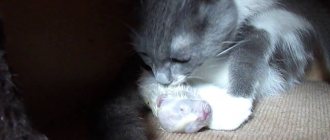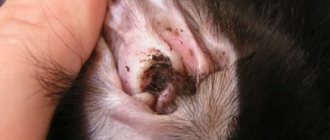It is always a good idea to take a closer look at the condition of your furry pet. The slightest changes in his behavior and/or appearance are the most important indicators that can indicate in advance the development of dangerous pathologies.
For example, small bald patches on a cat's face could be a sign of poor nutrition... or something more serious. For example, a fungus appears on a cat’s chin, some pathogens of which pose a serious danger to the life and health of your pet.
Causes of fungus
It is believed that strange bald patches on the chin may be a sign of ringworm (ringworm). This is a common group of fungal skin diseases that practicing veterinarians encounter very often.
Most pathogens of mycoses (for example, the Trichophyton fungus) have very high virulence, causing disease even in animals with a relatively normal immune system. Moreover, lichens are extremely dangerous because they are not species specific.
Remember! When interacting with a sick cat, both you and your family members risk getting sick. Other pets, including dogs, hamsters and other animals, can easily become infected.
But! Note that, regardless of the cause (i.e., the specific type of pathogen), the development of the disease is greatly facilitated by poor feeding, stress and allergies. These factors adversely affect the state of the animal's immune system.
Ringworm causes hair loss (hairs break off near the root), erythema and baldness. One of the distinguishing signs of many types of lichen is the appearance of round bald areas on the skin, in the center of which there is a red spot. Such lesions strongly resemble cigarette burns in their appearance.
Despite the presence of relatively specific symptoms, diagnosing dermatomycosis can be very difficult, sometimes dragging on for several weeks (the pathogen grows very slowly on nutrient media). The sooner the owner notices that something is wrong with his pet, the greater the chance of quickly treating the cat and avoiding infection himself.
Detailed description of possible causes
If a cat loses hair on its chin after black spots, red pimples, lumps or pink sores appear on it, then the reason may lie in scratching, since all of the above is accompanied by severe itching. Baldness of this area of the face in cats is almost always accompanied by accompanying symptoms that are difficult not to notice, as they cause a lot of discomfort to the animal. Especially in cases associated with an acute allergic reaction. Most often, this symptom is considered together with the following pathologies:
- Eosinophilic granulomas. Many veterinarians believe that eosinophilic granuloma can be caused by all types of allergies (food, atopic dermatitis, reaction to parasite saliva). Symptoms occur differently in each individual case. In some cases, single formations appear, sometimes the lesions spread to large areas of the skin. In many cases, chin hair loss in cats is caused by eosinophilic granuloma, which can be complicated by a secondary infection. First, the process develops against the background of redness of a separate area of the skin (usually the chin, lip, nose, less often the cheeks or ears). Then one or more pink plaques appear, slightly rising above the surface of the skin. For some, they are accompanied by severe itching; there are also cases when the formations do not bother the pet at all. Frequent licking of the lips and nose is also considered characteristic symptoms. Treatment in each case is individual, which should be based on local remedies and anti-inflammatory drugs. But, success will greatly depend on eliminating the provoking factor. Given that most allergies are not cured once and for all, exacerbations of eosinophilic granuloma in a pet can occur many times throughout its life. Good effectiveness was shown by daily treatment of the affected areas with a chlorhexidine solution (2-3 times a day), changing the brand of food, and eliminating plastic dishes from the animal’s diet.
- Lichen. It is more common in kittens and animals living outdoors. It is considered a contagious disease that can be transmitted to dogs and even humans. In rare cases, it occurs with minimal manifestations in the form of small spots on the skin. But, the most common form occurs when there is severe itching and hair loss. Most often the chin, ears, head are affected, and less commonly the limbs and tail. The spots can reach the size of a large coin. There is no fur inside the spot and there is weeping. There is almost always a flaky rim along the edges. If the animal reaches the lesions, it can lick or scratch them until they bleed. To make a diagnosis, an external examination of the animal by a veterinarian is required. Next, he will take scrapings from the lesions for microscopic and cytological examination. Good effectiveness is shown by glowing a cat under a Wood's lamp, where fungal spores will glow emerald. If the presence of fungal spores is confirmed, then depending on the severity of the symptoms and the age of the pet, treatment with antifungal drugs will be prescribed. Kittens under 8 weeks of age are prescribed only bathing with antifungal shampoos (Mikozoral, Perhotal, Nizoral, Imaverol). Adults are recommended to be treated with oral antifungal drugs (Terbinafine, Fungin). The duration of the course and dosage are prescribed by the veterinarian for each animal individually. Separately, it is necessary to write about the opinion of the majority of leading veterinarians in the country - vaccinations against lichen Vakderm and Polivac are not effective. It is recommended to pay special attention to disinfection of the premises and objects with which the infected animal comes into contact. For this purpose, products can be used that are marked as effective in killing dermatophytes. To speed up treatment and reduce the risk of spores spreading throughout the apartment, it is recommended to trim the sick animal.
Ways of transmission of fungal infection
Despite the increased virulence of many mycoses, an important role in infection/non-infection is played by the physiological state of the animal, its nutritional characteristics, and the presence or absence of strong stress factors.
The main route of transmission is direct contact between a healthy animal and a sick animal. In such cases, the infection rate exceeds 70% (i.e., if you come into contact with a sick cat, your pet has a 70% chance of becoming infected). In addition, fungal spores can end up on bedding, toys, brushes, clothing, gloves of owners, or even on fleas.
It is interesting that no one has conducted in-depth studies of the transmission of lichen using ectoparasites, but practicing veterinarians are 100% sure that this route of transmission is more than real.
Accordingly, the development of the disease is greatly facilitated by cramped living conditions. It is not surprising that in many cat shelters the infection rate of animals can quickly reach 100%. Despite this, the question still remains about the likelihood of infection after a single contact of a cat with contaminated care items.
But here, most likely, the main role is played by the number of transmitted spores. So, there probably won’t be a lot of them left on the scissors, but on the comb there will be plenty of “seeds” of the pathogen. The same goes for litter and cat baskets. You should only select new ones for your pet, or purchase them only from owners of guaranteed healthy animals.
Treatment of hair loss in cats
Treatment for alopecia in cats depends on the cause and can only be prescribed by a veterinarian. Treatment boils down to the following activities:
- symptomatic treatment: aimed at eliminating the underlying disease, the symptom of which was alopecia.
- for skin lesions by parasites: preparations for blood-sucking insects (specialized shampoos, sprays, drops);
- for infectious skin lesions: a course of antibiotic therapy;
- in case of allergies, contact with its source is excluded, and if necessary, a diet is prescribed;
- under stress: exclude factors, including those that cause licking and plucking of hairs.
The doctor will advise strengthening the immune system and increasing the resistance (stability) of the body with auxiliary means. In addition, balance the diet in terms of basic nutrients, taking into account the norms for cats of different ages, breeds, physiological conditions (pregnancy, feeding, castration, etc.).
Local medications and physiotherapy are used as an addition to the main treatment.
Treatment of alopecia is a long process that must be monitored by a veterinarian; its prescriptions must be followed exactly, since the first signs of hair restoration do not indicate a complete cure, and in advanced cases, hair may not be restored.
Symptoms of fungus in cats
Since primary symptoms often go unnoticed, in practice we often have to deal with already complicated (secondary bacterial infections) lichens. Alas, in such situations, animals not only have bald patches on the chin and other parts of the body: everything is much more serious.
Extensive foci of inflammation and scabs appear on the skin, and abundant exudate is visible from the ulcerated areas. The remaining fur becomes matted and turns into “icicles”, being glued together by the exudate. It is possible to develop infections of the upper respiratory tract and oral cavity (also fungal or secondary bacterial).
Please note that it is strongly recommended to cut sick pets, as there may be even more fungal lesions under the fur.
Causes of itching
Owners do not always immediately begin to sound the alarm when they discover scratching on their pet. Often they believe that this is not a very serious problem. If the scratching is minor and the itching does not particularly bother the cat, the owner can completely ignore this problem. But it is worth remembering that many diseases are curable only in the first stages. Therefore, it is important to promptly find out the cause of itching and provide professional help to your pet.
Lichen
This is an extremely contagious fungal disease that is also dangerous for humans. It is easily transmitted from a sick animal to a healthy one through short bodily contact, or even through grooming items (combs, nail clippers). Without timely treatment, lichen in dogs, like in cats, can lead to serious consequences for the health of the animal.
We recommend the article: What can cause a cat's eyes to water?
The main symptoms of lichen infection:
- The coat appears unhealthy. A large number of broken hairs.
- Small bald spots appear, which the cat actively scratches. They can be found primarily on the head, neck and paws.
- Hard crusts appear on bald spots.
- Lost fur grows back very slowly.
- Dandruff appears on the skin.
- In the final stages, purulent lesions form.
Skin parasites
Fleas are a very common parasite, especially among cats that have free access to the outdoors. Fleas are quite dangerous, because their bites lead to a decrease in the animal’s immunity. The cat becomes vulnerable to various bacteria and fungi. Flea bites cause severe itching, causing the animal to constantly scratch. Particularly sensitive cats may scratch their skin until it bleeds.
Your cat can also pick up ticks, lice and coccidia. However, the animal does not have to go outside for this. The owner may well bring some parasites with him on shoes and clothes.
The main symptoms of infection with skin parasites:
- deterioration in the appearance of fur;
- severe itching;
- anxiety;
- fleas and ticks can be seen visually if you look closely at the animal’s skin.
A tick bite can lead to quite serious consequences. At the same time, the animal’s temperature may rise, loss of appetite, and decreased activity.
It is best to consult a veterinarian to remove a tick. If the procedure is performed incorrectly, parts of the tick may remain in the animal's skin, which can cause a purulent abscess to form.
Allergy
An allergic reaction can occur completely unexpectedly in any cat. Most often, animals suffer from food allergies. It often manifests itself when changing the diet or adding new foods to it. Food allergies are the easiest to identify and therefore easy to combat.
But when diagnosing non-food allergies, problems can arise. In this case, it is not always possible to determine which allergen caused the body’s negative reaction.
An allergic reaction can be caused by:
- individual food products (often chicken and milk);
- pollen and plant parts;
- flea and tick bites;
- various chemical elements contained in cleaning products and perfumes;
- dust.
Otitis
Otitis of the external ear is a serious disease that can cause many problems for the animal. Infection of the ear canals leads to inflammation. The cat constantly shakes its head and scratches its face until it bleeds.
The main symptoms of otitis in a cat:
- redness of the ear;
- anxiety;
- the cat constantly shakes its head;
- the animal scratches its ears and muzzle;
- increased body temperature;
- In the absence of timely treatment, pus may begin to leak from the auricle.
Worms
Even completely domestic cats are not immune from infection with worms. Parasite eggs can enter the animal's body through raw meat, unwashed hands, clothing, and grass. Infection with helminths leads to decreased immunity and disruption of the body.
The main symptoms of helminth infection:
- Deterioration in the appearance of the coat, scratching.
- Defecation disorder.
- The animal quickly loses weight.
- Itching in the area of the anus, which causes the animal to rub it on the floor and carpets.
- Decline in activity or, conversely, excessive anxiety.
- In advanced cases, severe shortness of breath occurs.
Bacterial diseases
Bacteria and fungi are found in small quantities on the skin of any cat. Usually, they do not cause any problems to the animal. But if the animal gets sick, its immunity is reduced, and the body is weakened, fungi and bacteria begin to actively multiply, which often leads to severe itching and scratching.
We recommend the article: What causes diarrhea in a cat?
At risk are cats that already suffer from diabetes, allergies, and hyperthyroidism. This problem often occurs in kittens.
One of the most common bacterial infections in cats is pyoderma . Its main symptoms:
- severe itching;
- peeling of the skin;
- Scabs form on the wounds;
- baldness of certain areas of the skin;
- formation of purulent abscesses.
Pyoderma is very dangerous for cats. When the first symptoms appear, you should immediately consult a doctor.
Stress
All animals experience stressful situations differently. For some, moving or even ordinary fear can lead to not entirely adequate reactions. Constant licking of the same places may indicate mental disorders of the animal.
Of course, such a diagnosis can only be made after all other possible causes of itching have been excluded during the diagnostic process. The main symptoms of mental disorders and stress:
- refusal to eat;
- a decrease in activity or, conversely, excessive excitability;
- the animal constantly scratches or licks one place.
Breeds in which this problem most often occurs: Burmese, Orientals, Abyssinian and Siamese cats.
Disruption of hormone production
Disruption of the endocrine system leads to the appearance of various symptoms, including itching and scratching. A number of diseases that cause disruption of hormone production:
- Diabetes.
- Cushing's syndrome.
- Thyroid dysfunction.
Main symptoms:
- Hair loss and bald patches.
- Dryness and flaking of the skin.
- Severe itching and scratching.
Diagnostics
The most accurate method, which makes it possible to make a diagnosis with 100% probability, is growing a culture of the pathogen on a special nutrient medium, followed by microscopy. The problem is that fungi take a very long time to grow. Therefore, for “emergency” diagnostics, the so-called Wood’s lamp is often used. The idea is that some strains of dermatomycetes begin to fluoresce under UV radiation. True, this method does not always work.
In addition, the diagnosis is made on the basis of data obtained from conventional microscopy of hair samples and scrapings from the animal’s skin. In this case, it is highly advisable to tint the samples and conduct the study using oil lenses. In this case, the image in the field of view is more contrasting, and therefore it is much easier to detect the pathogen.
Causes of baldness in cats
The causes of baldness in cats can be congenital or acquired.
• Congenital include those that affected the body of a pregnant cat:
- lack of vitamins and minerals in the animal’s diet;
- stress;
- diseases of various nature;
- unbalanced diet;
- starvation and, as a result, exhaustion.
Exposure to these same causes even before pregnancy can serve as a prerequisite for the occurrence of alopecia in the future generation, as a result of which the fetus experiences disruption of the endocrine glands and disruption of the formation of hair follicles.
This should also include hereditary anomalies that arise, among other things, from inbreeding. However, it is important to clarify: if hereditary anomalies are accompanied only by the absence of hair (partially or completely), and not changes in the anatomical location of organs or disruption of their functioning, then we can talk about individual, and in some cases breed, affiliation. It is these anomalies that underlie the creation of cat breeds: Sphynx, Bambino, Elf, Ukrainian Levkoy, Cojona.
• Acquired baldness in cats can be a symptom of a disease of the skin itself:
- dermatitis (inflammatory skin diseases);
- seborrhea (increased secretion of the sebaceous glands);
- parasitic diseases (scabies) or fungal infections (ringworm, favus, trichophytosis).
This also includes alopecia, as a result of aging hair follicles, or from constant injury to certain areas of the hairline.
Another large group of factors that cause alopecia in cats are disturbances in the functioning of the body itself:
- stress: the cat itself intensively licks and plucks areas of the skin;
- allergies to food, medications, flea bites, odors, low-quality pet cosmetics, etc.;
- hormonal status disorders: diabetes mellitus, insufficient or excessive levels of thyroid hormones, adrenal glands, etc.;
- intoxication (acute or long-term infectious disease);
- inflammatory processes;
- blood diseases;
- condition after difficult childbirth;
- lack of vitamins, especially groups A, C, B;
- malignant tumors of internal organs.
In some cases, the cause of hair loss in a cat remains unknown, then we are talking about the unknown nature of baldness.










